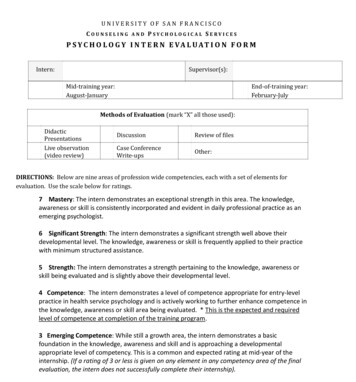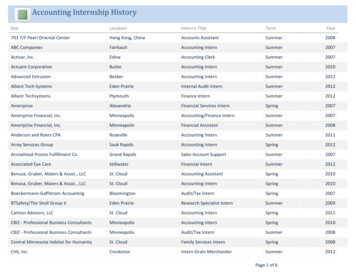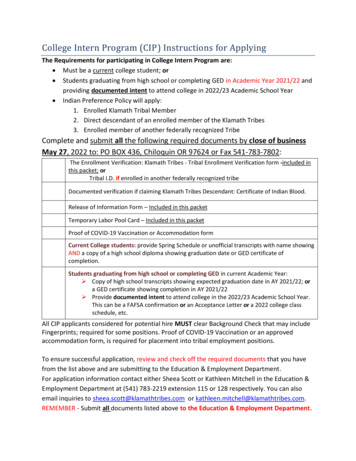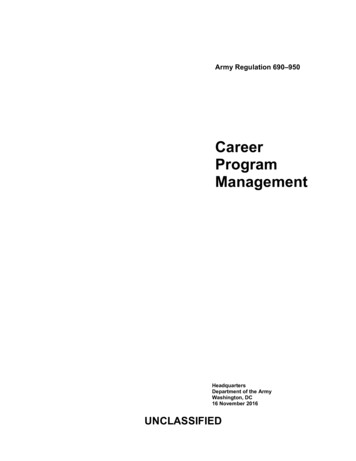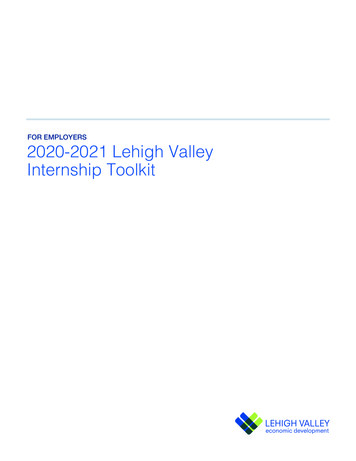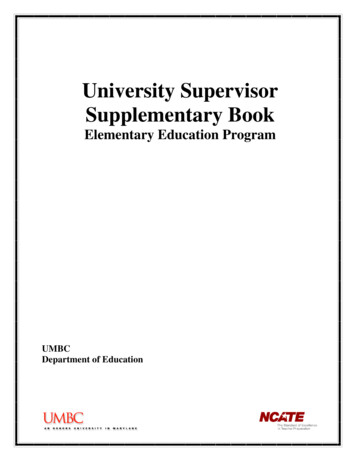
Transcription
SCHOOL OF EDUCATIONIntern HandbookForTeacher Candidates, Cooperating Schools, andUniversity SupervisorsV. 1.1
Table of ContentsWelcome!.1Mission Statements.2CI Mission Statement.2SOE Mission Statement .2School of Education Conceptual Framework.3Program Standards.4CI Intern Process .5Application and Admission Requirements .5Program Start Requirements .5Program Requirements .7Credential Program Principles and Goals .7Credential Program Requirements.7Additional Requirements.7Statement of Concern .9Program Overview.10Course Sequence .10Education Specialist Program .10Single Subject Program .11Intern Field Support and Seminar Overview .12Evaluation of Intern Candidates.12Placements.12Clinical Supervision Model.13Clinical Supervision Process .13University Supervisors .13Intern Candidates .13Roles and Responsibilities .15Intern Candidates .15University Supervisor Responsibilities.16School Site Responsibilities.17District Mentor.17Site Administrator.17Determination of Candidate Competence.18Recommendation for Credentialing .19Final Steps in the Program .19Appendix.20Teacher Candidate Data Sheet.21Emergency Contact Information Form .22Lesson Plan for Scripted Observation During Student Teaching for All Credential Programs.23CI Statement Of Concern .29Letter To Parents For Permission To Videotape.30
Scripted Observation for Teacher Candidates During Student Teaching .32Midterm/Final Evaluation.37Acknowledgement of Reading Handbook .39Employer Responsibilities for Intern Candidates .40Shared Responsibilities .43Intern Support Provider and Intern Candidate Services Log (General Support).45Intern Support Provider and Intern Candidate Services Log (English Learners Support).48Signature Page.52
Welcome!Dear Intern Candidates:Welcome to our intern program! The CI credential programs are designed specifically to prepareteachers for the diversity of learning abilities, languages and cultures encountered in California publicschools. An underlying principal of our program is that all students are capable learners regardless ofrace ethnicity, gender, ability, sexual orientation, or economic status. The programs follow theexpectations of the California Commission on Teacher Credentialing (CTC). Each candidate applies thehighest standards to his or her professional conduct.The intern program is designed to allow interns the opportunity to work full time as a teacher of recordwhile completing coursework and student teaching for their teaching credential. Juggling the demandsof being a new teacher while fulfilling the coursework requirements can be challenging, so to ensurethat intern candidates meet the same or higher procedural and performance standards as other teacherpreparation programs, you will receive ongoing support and supervision from a district mentor in theschool where you are employed as well as from a university supervisor. This is a wonderful opportunityto begin your teaching career while receiving support from the university and the district.CTC has strict policies and procedures for intern candidates so it is very important to provide the levelof support and documentation as required by CTC.Sincerely,CI Faculty and StaffIntern Handbook1
Mission StatementsCI Mission StatementPlacing students at the center of the education experience, California State University ChannelIslands provides undergraduate and graduate education that facilitates learning within and acrossdisciplines through integrative approaches, emphasizes experiential and service learning, andgraduates students with multicultural and international perspectives.SOE Mission StatementThe School of Education is devoted to the advancement of teaching and learning. Our image forteacher education begins with a vision for P-12 schools in the 21st century. The transformationfrom an industrial economy to an information society in the United States, combined with anincreasing emphasis on global issues and technology, demands more highly skilled adults to functioneffectively in the workforce. Young people who complete their schooling are the mosteducationally, socially and economically advantaged. They become adults who are lifelong learnersand have the basic skills necessary for leading a full and rewarding life in an interdependent societyand an information and service driven economy. The power of educators to make the fundamentaldifference in students’ lives makes education the most important social service.The School of Education builds from the foundation of the undergraduate Liberal Studies option inTeaching and Learning and academic majors in Science, English and Mathematics, History, andother undergraduate majors (subject matter programs) and extends to Master of Arts in Education. OurEducation programs contribute to the teaching profession by producing teachers and schooladministrators who believe that all students have the ability to achieve high standards, who adapttheir teaching to reach all students, and who respect the diversity of all students. Our graduates arereflective about their teaching, their attitudes, and their ability to work in collaborative analyticalteams. The Master of Arts in Education program focuses on Educational Leadership, SpecialEducation, and Curriculum and Instruction.Intern Handbook2
School of Education Conceptual FrameworkIntern Handbook3
Program StandardsThe California Commission on Teaching Credentialing (CTC) engaged in a consultative process witheducators to identify standards for the teaching profession. The standards have been designed in aprogressive, developmental sequence. The Credential Programs at CI use the Teaching PerformanceExpectations (TPE) Teacher Preparation Standards to guide what teacher candidates should learn andpractice. Once the Preliminary Credential is received, the California Standards for the TeachingProfessions (CSTP) are used as benchmarks for induction programs for beginning teachers.California Standards for the Teaching ProfessionThe TPEs are directly and purposely aligned to the California Standards for the Teaching Profession(CSTP) that guide California's teacher induction programs and ongoing teacher professionaldevelopment in California. This direct alignment signals to beginning teachers, preparers of beginningteachers, and those who support and mentor teachers in their first years of employment the importanceof connecting initial teacher preparation with ongoing support and development of teaching practice inthe induction years and beyond.Educator Preparation StandardsAll credential programs at CI have been approved by CTC. For a complete list of the Standards forEducator Preparation and Standards for Educator Competence at the CTC website please click here.Teaching Performance ExpectationsSix Teaching Performance Expectations (TPEs) define what teacher candidates need to know or be ableto do. All the TPEs must be learned and practiced by teacher candidates. The TPEs are written at anappropriate level for teacher candidates. There is an expectation that they advance as they progressthrough the credential program at CI. The TPEs are based on the California Standards for the TeachingProfession (CSTP).Teaching Performance Expectations (Summary)TPE 1; Engaging and Supporting All Students in LearningTPE 2: Creating and Maintaining Effective Environments for Student LearningTPE 3: Understanding and Organizing Subject Matter for Student LearningTPE 4: Planning Instruction and Designing Learning Experiences for StudentsTPE 5: Assessing Student LearningTPE 6: Developing as a Professional EducatorPlease click here to view and download the Teaching Performance Expectations document at the CTCwebsite.Intern Handbook4
CI Intern Process1. AdmisssionsRequirements Bachelor's degree Prerequisitecourses (17Units) Passing CBEST Passing CSETscores U.S. Constitution Offer ofemploymnet Completedapplications tothe universtiy andto the credentialprogram2. Program StartRequirements Admission to theuniversity as apostbaccalaureatestudent Admission to theCI teachingcredentialprogram Advisingappointment withintern coordinator3. ProgramMaintenanceRequirements Completion ofcourseworkmaintaining a 3.0GPA with nograde lower thana C Passing finalportfolio and /orteacherperformanceassessments Passing RICA CPR certificationfor adult, child,and infant4. CredentialingProcess Completion ofexit survey RICA and CPRcertification incredential officefile Schedule exitmeeting wtihcredential analystApplication and Admission Requirements1. Earned baccalaureate2. Successful completion of basic skills requirement by passing the CBEST or other appropriatebasic skills exam3. Demonstrate subject matter competency by passing the subject appropriate CSET exam4. Meet the U.S. Constitution requirement5. Completion of all required prerequisite coursework with a grade of C or better6. Note: Students possessing a Multiple or Single Subject credentials who seek admission to theSpecial Education Internship Program do not have to complete pre-requisite courses with theexception of SPED 4107. Offer of employment with a participating Ventura County or Santa Barbara public school districtin a teaching assignment which matches the credential being pursuedProgram Start Requirements1. Admission to the University as a post-baccalaureate student2. Admission to the teaching credential program or completion of all aspects of the credentialprogram application processIntern Handbook5
3. Advising appointment with intern coordinator to discuss requirements for being an interncandidate4. Enrollment in university coursesIntern Handbook6
Program RequirementsCI’s credential program prepares teacher candidates to work with students in standards-based, inclusiveschools. Our programs specifically prepare teacher candidates for the diversity of languages and culturesencountered in California public schools. The programs prepare intern candidates to address the diverselearning needs of students, including those who speak English as a native language and/or as a secondlanguage. The use of technology as a teaching and learning tool is infused throughout the program. Anunderlying principle of the program is that all students (regardless of race, ethnicity, gender, ability oreconomic status) are capable learners.Credential Program Principles and GoalsThe objectives of the credential programs at CI are to prepare effective and successful teachers forCalifornia public schools who: are reflective and deliberative practitioners are competent to teach the California State content standards are able to link content and pedagogy can integrate research, theory, and best educational practice into their teaching are able to integrate technology into their teaching understand and can meet the needs of diverse learners and special needs studentsCredential Program RequirementsPlease consult the University Catalog for required courses to successfully complete the credentialprogram. You can access the catalog and schedule of classes by clicking here.Additional RequirementsAll teacher candidates in all teaching credential programs will need to purchase an account onTaskStream.Intern Candidate Support Log. All intern candidates must submit and intern support log at the end ofeach semester in order to continue in the program.CPR: CTC requires certification in adult, infant, and child CPR for all teaching credential programs.RICA: CTC requires passing the Reading Instruction Competence Assessment (RICA) for the initialissuance of an Education Specialist credential. RICA consists of passing one of two components, eithera comprehensive examination or a video performance assessment. It is recommended that the RICA betaken after completion of the literacy methods course in the credential program.TPA: Teacher candidates in teacher preparation programs are required to pass a Teacher PerformanceAssessment (TPA) in order to be recommended for a preliminary teaching credential. At CI teachercandidates in the Single Subject credential program must pass the Performance Assessment forIntern Handbook7
California Teachers (PACT) in order to be recommended for a teaching credential. You can access thematerials for PACT by clicking here. PACT is submitted on TaskStream. Teacher candidates have twoopportunities to pass PACT. If teacher candidates do not pass PACT on the second attempt, they willhave a appeal to the chair of credential programs for an additional opportunity which may or may not begranted.Intern Handbook8
Statement of ConcernA statement of concern process will be followed unless a more serious situation occurs that necessitatesan intern candidate’s removal from the school site. At this time, a meeting with the intern candidate andthe responsible parties (school site administrator, district mentor, university supervisor, field placementdirector and intern coordinator) is required. Written statements from the district mentor and/or the schoolsite administrator are needed to document inappropriate behavior. It is crucial that all universitysupervisors follow this procedure as soon as a significant concern arises so that we may ensure qualityand integrity of CI’s Teacher Credential Program.1. When a district mentor or university supervisor identifies an intern candidate as havingdifficulty in some area of student teaching, they should discuss the areas of difficulty with eachother and the intern candidate.2. Academic concerns, such as being in danger of receive a grade lower than C or not being at3.0 GPA may also result in a statement of concern.3. If there is not sufficient change in the intern candidate’s work, then the university supervisorshall arrange for another field supervisor to observe the student. If sufficient reason forconcern is present, then the supervisors, district mentor, field placement director, interncoordinator, and intern candidate shall complete and sign a Statement of Concern and Plan ofAction form.4. The form details the steps that the intern candidate will take to address the issues outlined in thestatement of concern. This forms a plan of action. Specifics such as extending field experienceshould be included in addition to descriptions of the intern candidate’s work to beaccomplished.5. The intern candidate receives a copy of the signed Statement of Concern. The original isplaced in intern candidate’s credential office file.The above process will be followed unless a more serious situation occurs that necessitates an interncandidate’s removal from the school site. At this time, a meeting with the intern candidate and theresponsible parties (school site administrator, university supervisor, field placement director, and interncoordinator) is required. A written statement from the school site administrator is needed to documentinappropriate behavior.Intern Handbook9
Program OverviewThe intern program is a two-year program in which intern candidates are enrolled in coursework andprovided with a district mentor and university supervisor in the field. Each intern candidate will bevisited a minimum of 3 times per semester by their university supervisor for a scripted observation. Theuniversity supervisor as needed may conduct additional drop-in observations. Intern candidates alsoparticipate in an intern field support seminar in which they discuss topical issues with peers in similarteaching situations. The coursework is both time consuming and intellectually challenging. Any interncandidate aiming to become an intern should do an honest evaluation of their commitments outside ofschool to assess their ability to manage a course load and full-time teaching. Intern candidates must bepart-time students with a minimum of four semesters of study or longer as agreed upon with academicadvisor.Course SequenceEducation Specialist ProgramSemester 1 FallSPED 542: Managing Learning Environments (3 units)SPED 543: Curriculum and Instruction I (4 Units)EDUC 583: Intern Field Support (3 units)EDUC 584: Intern Field Support Seminar (1 unit)Semester 2 SpringSPED 541: Foundations of Special Education (3 units)EDUC 583: Intern Field Support (3 units)EDUC 584: Intern Field Support Seminar (1 unit)Semester 3 FallEDUC 538: K-12 Literacy (4 units)SPED 560: Access to Learning (2 units)EDUC 583: Intern Field Support (3 units)EDUC 584: Intern Field Support Seminar (1 unit)Semester 4 SpringSPED 544: Curriculum and Instruction II (4 units)SPED 545: Assessment (3 units)EDUC 583: Intern Field Support (3 units)EDUC 584: Intern Field Support Seminar (1 unit)Intern Handbook10
Single Subject ProgramSemester 1 FallEDSS 530: General Secondary School Methods (3 units)EDSS 560: Access to Learning: Special Needs Learners (2 units)EDUC 583: Intern Field Support (3 units)EDUC 584: Intern Field Support Seminar (1 unit)Semester 2 SpringEDSS 540: Literacy in the content Area (2 units)EDSS 550: Access to learning: English Language Learners (2 units)EDUC 583: Intern Field Support (3 units)EDUC 584: Intern Field Support Seminar (1 unit)Semester 3 FallEDSS 53(1,2,3 or 4): Teaching Content in Middle Schools (3 units)EDUC 583: Intern Field Support (3 units)EDUC 584: Intern Field Support Seminar (1 unit)Semester 4 SpringEDSS 54(1,2,3 or 4): Teaching Content in High Schools (3 units)EDUC 583: Intern Field Support (3 units)EDUC 584: Intern Field Support Seminar (1 unit)Intern Handbook11
Intern Field Support and Seminar OverviewEDUC 583 and 584 are designed to provide intern candidates with a university supervisor for fieldsupport and seminar. The role of the university supervisor is to support the intern candidate in meetingthe credentialing competencies, support the intern candidate in running a classroom, and to act as aliaison between the intern, university and school site. The CI lesson plan template and scriptedobservation forms are located in the appendix and can be accessed with hyperlink.Evaluation of Intern CandidatesThe university supervisor will observe and evaluate an intern candidate using the scripted observationrubric 3 times per semester. The level of support from the university supervisor is approximately 15hours per semester.At the end of the first semester of year 1, the university supervisor and district mentor will completethe midterm evaluation of the intern candidate. At the end of the second semester of year 1, theuniversity supervisor and district mentor will complete the final evaluation of the intern candidate toassess competencies met and those that need to be worked on in the coming semester. Thisevaluation cycle is repeated in year 2. The midterm and final evaluations are submitted via TaskStream.At the end of year 2, the university supervisor and district mentor will complete an IndividualDevelopment Plan (IPD) providing guidance to the intern candidate on how they will continue todevelop as a teacher during their induction program. The IDP is submitted via Taskstream.The university supervisor is responsible for the final grade. Written remediation plans will beprovided for intern candidates who are deficient in various areas, and additional periodic evaluationsmay occur when necessary. Petition or appeal procedures must follow procedures published by theUniversity.PlacementsIf both the district mentor and university supervisor agree that the intern meets the CTC standards fortheir role, the intern candidate can complete all field placement requirements in their own classroomwith observations in another setting for breadth. If either district mentor or university supervisor seesthe intern candidate as only partially meeting competency for their credential, then additional fieldplacements may be required.Intern Handbook12
Clinical Supervision ModelThe Clinical Supervision Model used at CI is designed to: Create trust between the intern candidate, district mentor, and university supervisorEncourage the intern candidate to analyze the lesson and student learningEncourage the intern candidate to examine alternativesEncourage the intern candidate to develop reflective skillsClinical Supervision ProcessUniversity SupervisorsThe process described below is a guide for university supervisors to use during the different stages ofsupervising intern candidates. While university supervisors need not address all points under each area,or address these in the order listed here, this list provides a reminder of key elements of the model. Pre-observation conference Observation Data Analysis including student work Post-observation conferenceOne week prior to the start of the semester or first week of the semester establish contact with yourintern candidate to arrange readiness meeting and to give them information on how to contact you. Thiswill be completed during the first week of the semester.Establish contact with the district mentor and site administrator during or prior to the first week of thesemester. At this meeting you will collect the signature page and submit to the credential office.Intern CandidatesIn addition to your teaching responsibilities, you will complete a set of observations, lesson plans,and assignments. Some of these assignments will overlap with course assignments.1. Lesson Plans Maintain a daily lesson plan book.Make this plan book available to your university supervisor during each visit.2. IEP Review student IEP goals and objectives with your university supervisor.Review student behavior plans and accommodations/modifications with your universitysupervisor.3. Maintain School CalendarsIntern Handbook13
Align district level responsibilities (e.g., IEP meetings and testing schedules) to districtcalendarsAlign university responsibilities (e.g., course schedules and assignment due dates) to theuniversity calendar4. Observe Exemplary Programs Observe exemplary programs once each semester.Your university supervisor will coordinate this activity including coordinating substitutecoverage with VCOE and your school district.In addition, you must meet with your district mentor for 2 to 4 hours per week and document themeetings using the intern candidate support log.Intern Handbook14
Roles and ResponsibilitiesIntern CandidatesProfessionalism. Always be the professional in dress, demeanor, and attitude. You may hear or seethings in classrooms with which you do not agree, or you may learn confidential information about astudent; it is essential to keep these issues confidential.Coursework: Complete the credentialing coursework within two years of starting the intern program.District Mentor: Schedule weekly classroom visits and with your district mentor. Contact districtmentor weekly for assistance in fulfilling district teaching responsibilities. Document your meetingsusing the Intern Candidate Support Log.Intern Candidate Support Log. It is your responsibility to submit this log to the credential office at theend of every semester you are in the intern program. Email the log to credential.assistant@csuci.eduand copy your university supervisor and district mentor. You supervisor will not issue you a grade forEDUC 583-Intern Field Support until they receive the proper documentation.Utilize University Supervisor. Schedule scripted observations with your university supervisor (3 persemester). Prepare lesson plans for your university supervisor prior to each scheduled observation(submitted on TaskStream 24 hours before your scheduled observation). Share any sort of difficulty inyour placement with your university supervisor immediately. The university supervisor provides anextra supportive pair of eyes to help you work through problems, and will serve as your advocateand assist you in communications with the university and your school site.Intern Candidate Data Sheet. Complete applicable items on the intern candidate data sheet and theemergency contact sheet and give this information to your university supervisor.Handbook. Read this handbook, Teacher Performance Expectations, and Standards. Signacknowledgement form that you have read and understood the information and give signed form toyour university supervisor.Absences. Always advise your university supervisor if and when you will be absent. Although mostvisits are prescheduled, occasionally supervisors stop by unannounced.Confidentiality and Parent Permissions. See your school district guidelines regarding confidentialityand photographing or videotaping of students, and parent permission forms.Professional Development. Attend district, VCOE, and CI workshops and trainings.Statement of Concern. Your university supervisor may issue an early warning if consistent and/orserious concerns arise. Intern candidates must follow CI procedures and take the necessary steps forimprovement.Ending Internship. Contact CI’s credential analyst immediately if your internship ends.Intern Handbook15
University Supervisor ResponsibilitiesSchedule Pre-Observation Meeting. During the first week of the semester, arrange a meeting timewith intern candidate, district mentor, and school administrator to review expectations of interncandidate and school.Intern Handbook. Provide a copy of Intern Handbook to school site administrator.Liaison. Serve as a liaison between intern candidate, district ment
intern coordinator 3. Program Maintenance Requirements Completion of coursework maintaining a 3.0 GPA with no grade lower than a C Passing final portfolio and /or teacher performance assessments Passing RICA CPR certification for adult, child, and infant 4. Credentialing Process Completion of exit survey RICA and CPR



